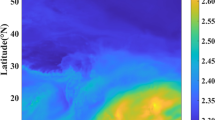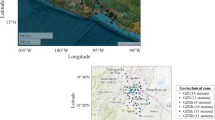Abstract
An attempt has been undertaken to examine time series of volcanic and seismic events in a multidimensional reference system related to the parameters of the Earth’s orbital motion. Volcanic eruptions and strong (M > 5) earthquakes (a sample from the USGS/NEIC seismological database: Significant Worldwide Earthquakes) [18] were analyzed within the fields of the JPL Planetary and Lunar Ephemerides, (DE-406) astronomical indicators [19]: the Earth-Moon distance, Earth-Sun distance, ecliptic latitude of the Moon, and the differences between the geocentric longitudes of the Moon and Sun, Venus and Sun, and Mars and Sun. Distribution spectra were obtained and normalization was performed taking the nonuniform motion of celestial bodies into consideration, and the values of multidimensional diurnal probability were calculated. As a result, the statistically reliable drift in the distribution of geoevents was calculated relative to the duration of the intervals of multidimensional diurnal probability, which indicates distribution regions where more geoevents can take place during shorter intervals (and vice versa). Linear relationships between the multidimensional diurnal probability and diurnal probability of geoevents were found. All these results and the astronomic ephemerides were used as a base for computing the probabilities of volcanic and seismic activity of the Earth for the period of 2005–2007. The spatial structure of volcanic and seismic processes was examined, which allowed the revelation of probabilistic parameters of the spatiotemporal structure of Earth’s geodynamic activity and outlining an approximate algorithm for its monitoring.
Similar content being viewed by others
References
Avsyuk, Yu.N., Prilivnye sily i prirodnye protsessy (The Tidal Forces and Natural Processes), Moscow: Schmidt Joint Institute of Physics of the Earth, Russ. Acad. Sci., 1966.
Avsyuk, Yu.N. and Levin, B.V, In Relation to M.V. Lomonosov’s Inquiry on the Earth’s Center Displacements (Analytical Review of RFFI (Russian Foundation for Basic Research) Grants to the 275th Anniversary of the Russian Academy of Sciences), Vestn. RFFI, 1999, no. 2(16), pp. 4–11.
Bakulin, P.I., Kononovich, E.V., and Moroz, V.I. Kurs obshchei astronomii (A Course of General Astronomy), Moscow: Nauka, 1983.
Venttsel, E.S., Teoriya veroyatnostei (Probability Theory), Moscow: Nauka, 1969.
Gushchenko, I.I., Izverzheniya vulkanov mira: katalog (Worldwide Volcano Eruptions: A Catalogue), Moscow: Nauka, 1979.
Darwin, G., The Tides and Kindred Phenomena in the Solar System, Boston & New York: Houghton, Mifflin Co., 1898 (Moscow: Nauka, 1965).
Levin, B.V. and Chirkov, E.B., Specific Features in the Latitudinal Distribution of Seismicity and the Earth’s Rotation, Vulkanol. i seismol., 1999, no. 6, pp. 65–69.
Lukashov, A.A. Rel’ef planetnykh tel (The Topography of Planetary Bodies), Moscow: Mosk. Gos. Univ., 1996.
Malysheva, L.K., Extra-Terrestrial Volcanism (Informational Review), Vulkanol. i Seismol., 2004, no. 6, pp. 65–77.
Markhinin, E.K., Vulkanizm (Volcanism), Moscow: Nedra, 1985.
Ocherki sravnitel’noi planetologii (Essays in Comparative Planetology), Moscow: Nauka, 1981.
Sidorenkov, N.S., Fizika nestabil’nostei vrashcheniya Zemli (The Physics of the Earth’s Rotation/Revolution Instabilities), Moscow: Fizmatlit, 2002.
Fedorov, V.M., Comparison between the Earth’s Volcanic Activity Chronology and Its Orbital Motion Characteristics, Vulkanol. i Seismol., 2001, no. 5, pp. 65–67.
Fedorov, V.M., Time Reference Systems in Geography, Vestn. Mosk. Univ., Geografiya, 2002, no. 4, pp. 21–26.
Fedorov, V.M., Comparison between the Earth’s Volcanic and Seismic Chronology and Its Orbital Motion, Izv. Akad. Nauk, Ser. Geogr., 2003, no. 5, pp. 16–20.
Fedorov, V.M., The Chronologic Structure and Probability of Volcanic Activity Due to the Tidal Deformation of the Lithosphere, Vulkanol. i Seismol., 2005, no. 1, pp. 44–50.
Fedorov, V.M., The Specifics of the Latitudinal Distribution of Volcanic Eruptions, Vulkanol. i Seismol., 2002, no. 4, pp. 39–43.
Data Base Significant Worldwide Earthquakes (2150 B.C.—1994 A/D/) (www.neic.cr.usgs.gov/neic/epic/epic_global.html).
Standish, E.M., Newhall, X.X., Williams, J.G., and Folk, W.M. Planetary and Lunar Ephemerides (DE-406), 1997 (www.willbell.com).
Additional information
Original Russian Text © V.M. Fedorov, 2007, published in Vestnik Moskovskogo Universiteta. Geologiya, 2007, No. 4, pp. 24–31.
About this article
Cite this article
Fedorov, V.M. A multidimensional analysis and the chronologic structure of the Earth’s geodynamic activity. Moscow Univ. Geol. Bull. 62, 234–243 (2007). https://doi.org/10.3103/S0145875207040047
Received:
Issue Date:
DOI: https://doi.org/10.3103/S0145875207040047




